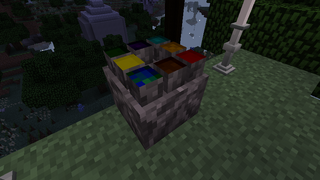Astronomy is one of the major gameplay mechanics of the Zenith. The sky of that dimension contains eight mobile planets and multiple static constellations; when a planet passes over a constellation, it may have a certain effect on the environment (mobs, terrain, or the player), with the planet determining the type of effect and the constellation determining what is being affected. Astronomy consists of the manipulation of this system to the player's benefit by means of the stellar altar.
Description[]
Constellations[]
Unlike the overworld, the Zenith has stationary stars that do not rotate with the sun and moon. Special large, twinkling stars in the Zenith's sky form a variety of constellations, shaped like different elements of the Zenith's gameplay (mobs, items, etc.). The following table lists each constellation and the effects produced by each planet while crossing over the constellation (detailed information on this process can be found in the next section).
Planets[]
Square planets move around the Zenith's sky randomly. Each planet is associated with a certain attribute; for example, Atlas is the planet of strength, while Penia is the planet of poverty and weakness. When a planet moves in front of a constellation, it confers an effect on the actual physical manifestations of whatever that constellation represents (such as the flower constellation affecting plants); this effect is an approximation of the planet's special attribute. For example, when Hermes, the planet of speed, crosses over the blue kite constellation, kites can move faster; their original speed returns when Hermes is no longer crossing their associated constellation. Some planet-constellation pairs are incompatible, however, (mostly when they would not make sense to be paired) and thus do not produce effects such as this.
Stellar Altar[]

A stellar altar. The block's top face depicts the eight planets, arranged in the same pattern as the GUI.
The stellar altar is a block used as a means to lock or freeze the position of a planet. This is useful because the planet will continue to produce its effect on the constellation over which it is hovering for as long as it is frozen in place. The player may choose which planets to freeze and for how long; freezing one planet for a given amount of time will cost a given amount of experience, currently one level per fifteen seconds (but this was determined to be too expensive and will be changed to one level per two minutes). There is an incentive for freezing all the planets simultaneously and for the same amount of time, as this costs only as much experience as freezing a single planet for that amount of time; under this situation, the player accepts the consequences of all the planets' present positions, for better or worse. The stellar altar cannot be crafted at the moment, and will ultimately be crafted using the drop of a rare miniboss.
Right-clicking on the stellar altar will lead to the block's GUI, which depicts the eight planets of the Zenith sky. Each

The stellar altar GUI. This player has taken advantage of Tyche's effect on the pickaxe and Hermes's on the blue kite, but he would not want to lock Ares over the blue kite or Limos over the pickaxe due to their negative effects.
planet's entry consists of, respectively, the planet's name, its special characteristic or effect, the constellation over which it is currently crossing (if applicable), and the amount of time (in minutes and seconds) that it will remain locked in place if it has been frozen. Right-clicking on a planet's entry allows the user to modify the last factor in exchange for the depletion of some experience, as described above. The middle of the GUI contains information on the cost of the planet freeze, in experience levels. Clicking the "Freeze planets" button applies the changes the user has made and consumes the appropriate amount of experience; clicking this button without a sufficient level of experience, or without making any changes, will obviously have no effect.
Antikythera Device[]
The antikythera device is a planned item that would be able to predict the future positions of the planets at various points in time up to a certain number of nights in the future. This feature is not yet implemented.
Telescope[]
The telescope is an astronomy-related item that is used to zoom the player's vision so that he may see distant objects, like planets and stars, in detail. Right-clicking with the telescope in hand will allow the player to use this item; the Z key can then be pressed to zoom in and out. The maximum zoom factor is eight. The player loses some peripheral vision to the telescope's barrel while looking through it, and a large, black crosshair displays in the center of the screen. A second right click will deactivate the telescope.
Known issues[]
- The stellar altar occasionally does not lock the planets in place but expends the user's experience anyway.
- The amount of experience taken to lock planets has not been balanced yet.
- The player's hotbar still appears when the telescope is activated.
- Planets render behind constellations as opposed to in front of them.
- Normal stars do not render brightly enough.
Future plans[]
- The antikythera device will be added at a future date.
- Many more constellations, including those that have been described but not implemented, will be added.
- Astronomical effects still need to be added.
- The stellar altar model's depictions of the planets will rise and lower to express which planets are locked into place and which are not.
- The stars of constellations will be given a twinkling animation.















